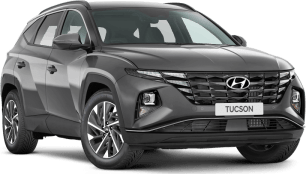The Hyundai Tucson has long been one of the value players in the mid-size SUV market, often with drive-away deals done for less than thirty grand.
That’s not going to be the case this time around, with prices up across the board, and while there have been a number of additional safety items added, some of the exclusions seemingly make the inclusions and price adjustments look a little bit questionable.
Here’s a price list to help you understand the range - it’s a little complicated. Oh, and yes, the base model is known simply as Tucson, with the mid-spec model the Elite and top-end grade being the Highlander.
As you can see, there’s one powertrain for the base model, and three engine options for the mid- and high-grade versions.
Standard equipment for the Tucson grade includes: halogen headlights, LED daytime running lights, 17-inch alloy wheels, a leather steering wheel, 8.0-inch touchscreen media system with wireless Apple CarPlay and Android Auto, four USB ports, tyre pressure monitoring, a 4.2-inch driver info screen, drive mode selector (Eco, Normal and Sport), cloth seat trim, manual adjust front seats, manual air-conditioning, turn key ignition, auto folding door mirrors, and 'premium door and dash trim.'
The Tucson grade scores a reversing camera, rear parking sensors, and an array of active safety technology that helps justify the price increase - read about that in the safety section below.
The Elite grade scores plenty of extras including 18-inch alloy wheels, keyless entry, push-button start, leather seat trim, heated front seats, power drivers seat adjust, dual-zone climate control, rain-sensing wipers, rear tinted glass, a larger 10.25-inch touchscreen media system with sat nav - plus a couple of added safety items. But you’re still getting halogen headlights on a car approaching $50K on the road. Yikes.
Topping the range for now is the Highlander variant, again available with a choice of three powertrains - but those prices are getting high.
Features include 19-inch wheels, LED headlights, LED rear lights, LED interior mood lighting, heated and cooled front seats, heated rear seats, a heated steering wheel, a 10.25-inch digital instrument cluster, Bose sound system, power tailgate, a panoramic sunroof, a 360-degree surround view camera, and something called a 'passenger walk-in device', which is a set of electric seat adjustments on the front passenger seat that the driver can control.
Diesel versions also get the 'Remote Start Parking Assist System', which means you can park the car using the key. Watch Richard Berry’s review of the Kia Sorento to see how that works.
I think it’s really poor Hyundai is offering halogen lights (they’re not very good on dark roads, I tested them!) on a car featuring so much other new tech. And if you hate that as much as me, fear not - there is a way around it.
Buyers can option the N Line pack on all grades, and here’s a rundown of the prices with that pack:
The model grade you apply the pack to will determine the extra equipment you get. And it actually looks like pretty good value for all grades, with the Tucson adding $3500, the Elite adding $2000 and the Highlander $1000.
The brand reckons 50 per cent of customers will choose the pack - I’m not so sure that’ll be the case.
But what you get is worth the money. In the Tucson you add 19-inch alloy wheels, leather and suede seats, a 10.25-inch digital instrument cluster, LED front and rear lights including auto high beam lighting, gloss black grille, N Line skid plate design, N Line badging and the N Line sports body kit.
For the Elite, the changes are identical. For the Highlander, you’re switching 19s for 19s, and you already have all the LED lighting, the 10.25-inch driver screen, so it’s more a cosmetic upgrade inside and out. But for $1000 it’s enticing.
In a hurry to get your new Hyundai Tucson, and after one that’s not a 2.0L petrol? There’s bad news. The Tucson 1.6T AWD won’t arrive until June, while the 2.0D AWD models will be here in the third quarter, along with any models fitted with the N Line Pack.
Colour choices for the Tucson range include: 'Shimmering Silver', 'Amazon Grey' (actually dark green), 'Silky Bronze', 'Deep Sea Blue', 'Crimson Red', 'Titan Grey', 'White Cream' and 'Phantom Black.' Only white is no cost, the rest are $595.
For the Tucson grade the interior is black cloth, while Elite has black leather interior trim. The Highlander can be had with black leather, grey leather, or brown leather trim.
Changing from black to the other colours adds just $295 to the price.





